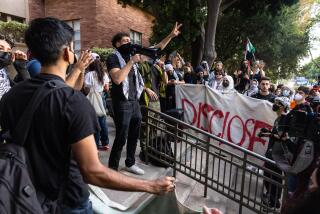March marks ’68 Mexico killings
MEXICO CITY — Thousands of Mexicans marched across their nation’s capital Thursday to demand justice for victims of a 1968 massacre of students by government troops -- contemporary Mexico’s most traumatic atrocity and one that remains unresolved.
Survivors of that bloody night 40 years ago and Mexicans who had not been born then joined forces, chanting “Dos de octubre! No se olvide!” (Oct. 2! Don’t forget!) as they converged on the downtown Zocalo plaza.
“I remember how the tanks rolled over the dead and the injured, how they attacked a number of my friends with bayonets,” said Cuauhtemoc Padilla Marroquin, a teacher who was 15 when the massacre took place.
The killings -- official reports put the toll at 25 to 43 but human rights groups have long maintained that the number was closer to 350 -- started when government forces opened fire on a massive but peaceful student demonstration just days before the Olympic Games were to open in Mexico City. It was a time of political effervescence in the country and across the globe, and the Mexican government of the day was eager to conceal what had happened.
The incident in the Plaza of the Three Cultures, in the Tlatelolco zone of Mexico City, remained shrouded in secrecy for decades. Subsequent Mexican governments were not willing to appoint a truth commission to investigate, and two that were finally formed in the 1990s were ineffective. An accurate death toll was never established, and efforts by special prosecutors to try officials blamed for the massacre, including former President Luis Echeverria, failed.
“We can’t forget that night because those responsible haven’t been punished as they should have, and no society should forget something so traumatic, so as not to repeat it,” said Hector Mora, 45, a professor at Mexico’s National Autonomous University who was leading a group of his students in Thursday’s march.
Some Mexicans argue that the failure of authorities to punish those responsible for the massacre has had long-lasting repercussions, including the stoking of Mexico’s entrenched culture of impunity, in which rampant killings and kidnappings are rarely resolved.
“Today, some students didn’t come to class because their parents didn’t let them -- because some people still believe that Oct. 2 can be dangerous,” Mora said. “The trauma continues for some.”
Natalia Gonzales Servin, 18, was in Mora’s group.
“When I was little and my mother told me what happened [that night], I couldn’t believe it,” the student said. “How could it be possible that so many people died and the people did nothing and the media less?
“But as I grew up, I realized that a lot of things happen but people don’t act -- it’s like they’re asleep. 1968 was an awakening.”
Mexico City’s leftist mayor, Marcelo Ebrard, ordered flags flown at half-staff Thursday in memory of the dead. At the federal level, under the authority of conservative President Felipe Calderon, there was no 40th anniversary commemoration.
Amnesty International called on Calderon to establish the truth once and for all as the only way to heal “a deep scar in Mexican society.”
“President Calderon’s government has been all but silent on this dark chapter in Mexico’s history,” the London-based human rights organization said. “We challenge this administration to open all relevant archives and records, establish a new and independent inquiry and lift the obstacles preventing those responsible for this horrific crime being brought to justice.”
Javier Zuniga, now an advisor to Amnesty International, was a teacher in 1968 and recalled taking his wife and child that night to what was supposed to be a peaceful demonstration. The army moved into the square, gunfire rang out as dusk fell, and the crowds tried to flee in panic; the next day, piles of bloodied clothes littered the square.
“Forty years on from the Tlatelolco massacre, so many disturbing questions remain unanswered,” Zuniga said in a statement released by Amnesty. “Who ordered the massacre? For how long had it been planned? How many were killed? Who are those whose bodies still have not been identified?”
Echeverria, the former president who was interior minister at the time of the massacre, was placed under house arrest in 2006 and faced possible genocide charges related to the 1968 killings. But last year, a federal court dismissed the charges -- while ruling that genocide had taken place because “government authorities at the time jointly conducted a prearranged and coordinated action aimed at exterminating a national group of students from various universities.”
The president at the time of the massacre, Gustavo Diaz Ordaz, also was never prosecuted or charged.
Despite government efforts at secrecy, the events of that night came to light over time, thanks to the work of ground-breaking Mexican journalist Elena Poniatowska and survivors who have also published their own accounts. A multimedia exhibition was opened early this year on the site of the killings.
Turnout at the annual marches has waned over the years. Padilla Marroquin, the survivor participating Thursday, stressed the importance of representing those who died.
“We carry on fighting because I know that if I had died that night and some of my friends had survived, they would be here where I am today.”
--
--
Cecilia Sanchez of The Times’ Mexico City Bureau contributed to this report.
--
On latimes.com
La Plaza
For news, observations and links about Latin America by Times correspondents, go to latimes.com/laplaza.
More to Read
Sign up for Essential California
The most important California stories and recommendations in your inbox every morning.
You may occasionally receive promotional content from the Los Angeles Times.











